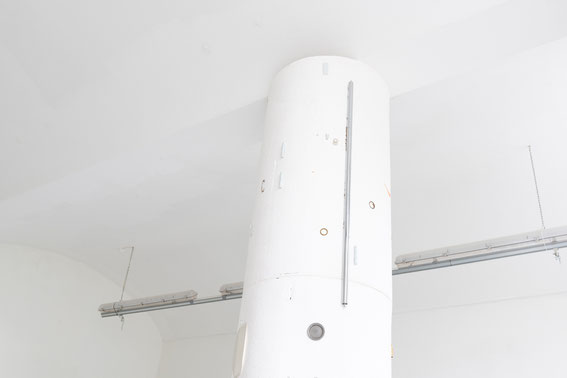Localized Pressures
Jahresausstellung 2023
22 – 30 Jul 2023
Haha Wang, Yuchu Gao, Bokyoung Jeong, Zhenyu Sun, Michael Mönnich, Laura Klodt-Bußmann, Nils Peisker, Elisabeth Hofstetter, Janis Strobl, Hannes Borgmeier, Gloria Sogl, Rebecca Ruchti
Photos: Michael Mönnich
Class Room 1 (A.EG.10, ground floor)
The works in the main class room feature localized alternative forms of labour and living. The activists protecting the Hambacher Forst from coal mining activities in Haha Wang’s video WOULD
YOU WOULD YOU WOULD YOU...?, live in the tree tops, while the community of all-female free divers in Yuchu Gao‘s installation of drawings and sculptures gather their bounty at the bottom of
the ocean. The geographical distance between the Haenyeo divers of South Korea and the activists in Germany, is mirrored by the spatial bracket in which their actvities take place. Between the
dizzy heights and dark depths of their respective spheres lies the mundane urban pavement we walk on everyday, the elements of which Bokyoung Jeong is reflecting in her floor piece which acts as
a threshold to the exhibition space.
Ceramic Workshop (A.U1.11, basement)
The works in this room explore various implications of technological progress as well as economic optimization and functionalization. A deep drilling on the premises of a vacant gas station serves as the starting point for Elisabeth Hofstetter's installation. The unstable and non-cooperative ground there had been declared as not sufficiently load-bearing for a more lucrative usage such as a multistory building. Adjacent to this work is Dixi by Janis Strobl, the full-scale textile replica of a portable toilet. For the duration of the exhibition the ready-made original is placed in an undisclosed location in the urban realm of Munich where it acts as a camouflaged storage facility for some of her belongings. Hannes Borgmeier’s large-scale ceramic sculpture incorporates a multitude of handles, hangers and connectors. Even though they invoke a vague functionality they are only able to support the fragile structure they themselves are a part of. A series of portraits by Gloria Sogl depict fictionalized versions of her grandmother who maintained a writing practice throughout her life while working as a weaver. On the basis of her writings they were produced with the help of an AI-based text-to-image-generator and woven on a programmable Jacquard loom, an early ancestor of contemporary computers. The relations between textile and text, weaving and programming which become apparent in these works are all tied together by a history of gendered, predominantly female labour. Finally, Rebecca Ruchti’s video piece is a poetic reflection on the disconnected presence of watchdogs she came across in Marseille. During the heat of the day the dogs lie silently in front of the supermarkets they are ordered to protect. But at night their disembodied voices, at least temporarily freed from their muzzles, roam the dormant neighbourhood.
Class Room 2 (A.U1.12, basement)
A couple of months ago Zhenyu Sun turned his tiny student flat into a second hand shop called Sun Set. Reacting to the economic pressures of the city of Munich, his new way of living in
a shop display also inspired a new set of works. Sun deconstructs second-hand denim trousers, cheaply bought by the kilogram in China and reconstructs them into new trousers by mixing up the
individual parts. He then sells them on to Second-Hand shops in Munich only to buy them back at a later point, thus illustrating the (international) cycles of garments and the changing values
attributed to them. The thematic throughline of labour permeating private space is also present in Michael Mönnich's series of videographic vignettes. Encounters with animals caught up in their
routine of mundane survival are used as opportunities for his own exercises in camera work. In following birds and insects that inhabit urban space, he is searching for modes of image production
shaped by the everpresent pressures of everyday life. Laura Klodt-Bußmann‘s towering column, made from paper pulp is barely able to support itself, let alone the ceiling of the exhibition space.
It is covered with fixings and fragments of structures used to create order in everyday life, which she pressed into the wet pulp. Not completely abstract but having lost all use value they hover
between decoration and attempts at some sort of language. Nils Peisker’s abstract ceramics display intricate relationships of positive and negative space, inside and outside. They follow
principles of rotation symmetry, the order of which is difficult to grasp from just one viewpoint. Without a bottom they are useless for storing or holding anything, yet still stem from his
research into the history of ceramic vessels closely linked to that of reproductive labour as well as into architectures of power.
Yuchu Gao, Haha Wang, Bokyoung Jeong
Bokyoung Jeong
Yuchu Gao
Yuchu Gao
Haha Wang
Hannes Borgmeier, Elisabeth Hofstetter, Janis Strobl
Rebecca Ruchti
Janis Strobl
Elisabeth Hofstetter, Hannes Borgmeier
Gloria Sogl
Michael Mönnich
Hannes Borgmeier
Nils Peisker, Zhenyu Sun, Laura Klodt-Bußmann
Zhenyu Sun
Nils Peisker
Laura Klodt-Bußmann
Laura Klodt-Bußmann
Zhenyu Sun


















